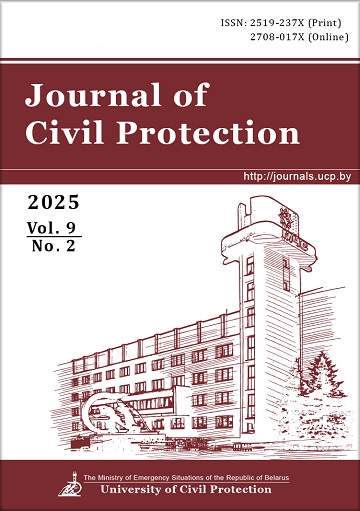Interactive technologies in shaping a culture of safety: the potential of social platforms of the Ministry for Emergency Situations of Belarus
DOI:
https://doi.org/10.33408/2519-237X.2025.9-2.280Keywords:
safety, life safety culture, interactive technologies, pedagogical innovations, digital educational environment, value education, social platformsAbstract
Purpose. To identify the didactic and educational potential of interactive technologies in shaping value-based attitudes toward a culture of safety, based on the activities of social platforms for the formation of a culture of safety (SPFCS) under the Ministry for Emergency Situations of the Republic of Belarus.
Methods. The research employed comparative, systemic, and historical-genetic methods of analysis. The theoretical framework is based on the principles of scientific cognition, including scientific validity, systematicity, and objectivity. Elements of pedagogical modeling and content analysis of interactive practices were also applied.
Findings. A comprehensive analysis was conducted of the functions of the SPFCS as educational and formative platforms aimed at developing sustainable models of safe behavior. Interactive teaching methods were examined, including virtual simulations, business games, case studies, sensory interfaces, and digital platforms. The study revealed the high effectiveness of such technologies in shaping cognitive, practical, and value-oriented components of a culture of safety. Special attention was paid to the pedagogical potential of digital tools and the role of interpersonal interaction in educational environments. The study substantiates the need for further modernization of the SPFCS in light of the challenges of the digital age and the priorities of learner-centered education.
Application field of research. The results can be used in developing programs for training the population on safety issues, in methodological recommendations for educational institutions and in the training of employees of the Ministry for emergency situations involved in activities to develop a culture of life safety.
References
Kazakova I.M. Virtual'naya ekskursiya kak perspektivnaya forma muzeynoy prezentatsii [Virtual tour as a promising form of museum presentation]. Magileushchyna: collection of articles on archaeology, history, and local lore of the Mogilev region. Mogilev, 2014. Iss. 12. Pp. 204–205. (rus)
Kibirev A.A., Verevkina T.A. Interaktivnye metody obucheniya: teoriya i praktika [Interactive teaching methods: theory and practice]. Khabarovsk: Khabarovsk Regional Institute for Retraining and Professional Development of Pedagogical Staff, 2003. 117 p. (rus)
Suvorova N.G. Interaktivnoe obuchenie: novye podkhody [Interactive learning: new approaches]. Uchitel', 2000. No. 1. Pp. 25–27. (rus). EDN: https://elibrary.ru/STJTMH.
Yanitskaya P.A. Sintez informatsionnykh tekhnologiy i nauchno-prosvetitel'skoy deyatel'nosti kak odin iz aspektov razvitiya sovremennogo muzeya [Synthesis of information technologies and educational activity as an aspect of museum development]. Proc. of the Republican scientific-practical conf. «Muzeynaya adukatsyya і muzeynaya sprava u Respublіtsy Belarus': stan, tendentsyі, perspektyvy», Minsk, November 24, 2011. Belarusian State University of Culture and Arts. Minsk, 2012. Pp. 135–138. Available at: http://repository.buk.by/jspui/handle/123456789/1168 (accessed: March 10, 2025). (rus)
Nikonova L.E., Pozdeeva T.V. Pedagogicheskie osnovy formirovaniya kultury bezopasnosti u starshikh doshkol'nikov [Pedagogical foundations of forming safety culture in senior preschoolers]. Proc. of the Republican scientific-practical conf. «Zdorov'esberegayushchie tekhnologii v doshkol'nom obrazovanii: teoriya i praktika», Brest, October 19, 2012. Brest: Brest State A.S. Pushkin University, 2012. Available at: http://elib.bspu.by/handle/doc/23478 (accessed: March 10, 2025). (rus)
Babakov S.A., Gunina L.M., Zaderey A.V., Kalinka S.N., Kleban A.E., Chumila E.A. Propaganda bezopasnosti zhiznedeyatel'nosti [Life safety promotion]. Minsk: University of Сivil Protection, 2021. 232 p. (rus)
Gafner V.V. Predposylki vozniknoveniya pedagogiki bezopasnosti [Prerequisites for the emergence of safety pedagogy]. Proc. of All-Russian conf. with international participation «Pedagogika bezopasnosti: nauka i obrazovanie», Yekaterinburg, December 12, 2011. In 2 parts. Yekaterinburg: Ural State Pedagogical University, 2012. Part 1. Pp. 5–12. (rus)
Ayzman R.I., Petrov S.V., Shirshova V.M. Teoreticheskie osnovy bezopasnosti zhiznedeyatel'nosti [Theoretical foundations of life safety]. Novosibirsk: ARTA, 2011. 208 p. (rus). ISBN 978-5-902700-18-0.
Yesipova A.A., Rebko E.M. Osnovnye strukturnye komponenty kultury bezopasnosti zhiznedeyatel'nosti [Main structural components of life safety culture]. Molodoy uchenyy, 2014. No. 18-1. Pp. 36–38. (rus). EDN: https://elibrary.ru/SYARQT.
Bezopasnost' cheloveka [Human safety]: study guide for educational institutions. Ed. by L.I. Shershnev. Moscow: National and International Safety Foundation, 1994. 472 p. (rus)
Chagin D.P. Ispol'zovanie elektronnogo obucheniya s vozmozhnostyami 3D-modelirovaniya v kurse OBZh [Using e-learning means with 3d-simulation facilities in the course of basics of life safety]. Man and Education, 2010. No. 3. Pp. 74–78. (rus). EDN: https://elibrary.ru/NCRVQZ.
Nikolaeva L.S., Lesnykh L.I. Ispol'zovanie netraditsionnykh form zanyatiy [Use of non-traditional forms of classes]. Spetsialist, 1992. No. 2. Pp. 5–6. (rus)
Karpievich V.A., Kulik A.N. Vozmozhnosti ispol'zovaniya interaktivnykh metodov v kompleksnom podkhode k obucheniyu osnovam bezopasnosti zhiznedeyatel'nosti [Possibilities of using interactive methods in a comprehensive approach to teaching life safety fundamentals]. Innovatsionnye obrazovatel'nye tekhnologii, 2015. No. 2 (42), Pp. 31–36. (rus). EDN: https://elibrary.ru/XWFKNL.
Guzeev V.V. Osnovy obrazovatel'noy tekhnologii: didakticheskiy instrumentariy [Fundamentals of educational technology: didactic tools]. Moscow: Sentyabr', 2006. 191 p. (rus). EDN: https://elibrary.ru/QVFMYL.
Myasoed T.A. Interaktivnye tekhnologii obucheniya [Interactive learning technologies]. Moscow: VLADOS, 2004. 82 p. (rus)
Stupina S.B. Tekhnologii interaktivnogo obucheniya v shkole [Interactive learning technologies in school]: study guide. Saratov: Nauka, 2009. 52 p. (rus). ISBN 978-5-91272-909-6.
Published
How to Cite
License
Copyright (c) 2025 Lasuta G.F., Bogdanovich A.B., Shchur A.S.

This work is licensed under a Creative Commons Attribution-NonCommercial 4.0 International License.




















